
|
 |
|
|
 |
| |
You
like violin... |
|
|
 |
| |
Order
it Now ! |
| |
|
|
|

|
| |
|
JEAN-BAPTISTE VUILLAUME
1798-1875
|
Born to a Mirecourt
family since both his grand-father and his father
were engaged in the same trade, Jean-Baptiste Vuillaume
arrived in Paris in 1818 to work for François Chanot.
In 1821, he joined the workshop
of Simon Lété, François-Louis Pique's son-in-law,
rue Pavée St Sauveur. He became his partner and in
1825 settled in the rue Croix des Petits-Champs under
the name of "Lété et Vuillaume". His first labels
are dated 1823.
This constitutes his first period.
Beginning in 1827,
at the height of the Neo-Gothic period when many artists
were drawing their inspiration from 15th and 16th
century cathedrals and monuments, and in order to
satisfy the infatuation of virtuosi and amateurs with
great 18th century Italian violin makers, he started
imitating old instruments. Some copies were so perfect
that, at that time, it was difficult even for a discerning
eye to tell the difference.
In 1827, he won a
silver medal at the Paris Universal Exhibition.
The following year, in 1828, he set his own business
at 46 rue des Petits-Champs and began creating his
own models.
This constitutes his second period.
|
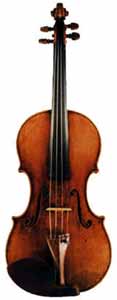
"The
Kreisler"
|
|
a
copy of "The Ole Bull"
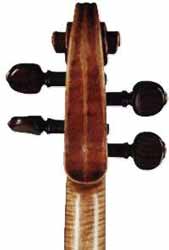
|
His workshop then
became the most important in the capital. Within
barely twenty years, it became the leading workshop
in Europe. A major factor in his success was doubtless
his purchase of 144 instruments made by the most
celebrated Italian masters, including 24 Stradivari
and the famous "Messiah" presently kept at the Ashmolean
Museum in Oxford (England), from the heirs of an
Italian tradesman named Tarisio, for 80,000 francs
in 1855.
In 1858, in order
to avoid paying the capital's custom-duties on his
wood imports, he settled rue Pierre Demours, near
the Ternes, which were at that time outside Paris.
He was then at the
height of his reputation, having won various gold
medals in the Competitions of the popular Paris
Universal Exhibitions in 1839, 1844 and 1855, the
Council Medal in London in 1851 and, in that same
year, the Legion of Honour.
|
|
His third period,
the Golden Period, took place during the 1860s.
A maker of more than
3,000 instruments - almost all of which are numbered
- and a fine tradesman, Jean-Baptiste Vuillaume was
also a gifted inventor as is demonstrated by his research
in collaboration with the acoustics expert Savart.
He also invented a viola which he called a "contralto",
the "Octobasse", bows with fixed nut and interchangeable
hair, and hollow steel bows, particularly appreciated
by Charles de Bériot, among others. Other innovations
include the insertion of microfilms (!) in the eye
of the frogs of his bows, a kind of mute (the "pédale
sourdine") and several machines, including one for
manufacturing gut strings of perfectly equal thickness.
Most 19th century
great bow makers collaborated with his workshop: Persois,
Dominique Peccatte, Guillaume Maline, François-Nicolas
Voirin and Joseph Fonclause are among the most celebrated.
|
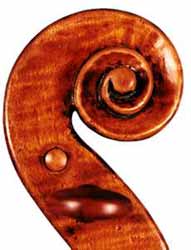
"The
Kreisler"
|
|
"The
Count Doria"
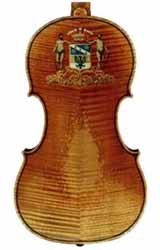
|
Jean-Baptiste Vuillaume
was not only a violin maker, a tradesman (he travelled
all over Europe in order to find instruments), and
an innovator, but also a highly talented restorer.
Due to this fact,
most instruments by the great Italian violin makers
passed through his workshop. Vuillaume then made accurate
measurements of their dimensions and made copies of
them. He drew his inspiration from two violin makers:
Antonio Stradivari, his favorite violin being the
"Messiah", and Giuseppe Guarneri del Gesù and the
"Cannone" which belonged to Niccolo Paganini; others
such as Maggini, Da Salò and Amati were also imitated,
but to a lesser extent.
When making these
copies, Vuillaume always remained faithful to the
essential qualities of the instruments he imitated
- their thickness, the choice of the woods, the shape
of the arching. The only differences, always the result
of a personal decision, were the colour of the varnish,
the height of the ribs or the length of the instruments.
|
|
His most beautiful
violins were decorated with the arms of the Princes
who ordered them (Caraman de Chimay, Cheremetoff,
Doria), or bore either the name of important biblical
characters (the Evangelists) or bird names (the golden
pheasant, the thrush.).
He also had practice
violins, known as "St Cecilia violins", made by his
brother Nicolas de Mirecourt.
|
|
The general characteristics
of his instruments are as follows :
- his main contribution to violin
making was his work on varnish
- the purfling's joints are often
cut on the straight and not on the bias as tradition
requires, in the middle in the pin
- his brand is burnt at a length
of 1 cm
- there is generally a black dot
on the joint of the top under the bridge
- he used an external mould
- the stop is generally 193 mm long.
In this respect he follows to the French 18th century
tradition of a short stop (190 mm), which was traditionally
195 mm long in Italy and even 200 mm long in Germany
- its serial number is inscribed
in the middle inside the instrument
- its date (only the last two figures)
in the upper paraph on the back
|
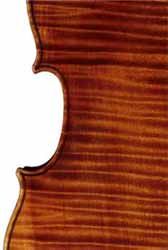
"The Golden
Pheasant"
|
|
His violins of the
first period have large edges and his brand was then
burnt inside the middle bouts.
The varnish varied from orange-red
to red. After 1860, varnish became lighter.
In addition to the
above-mentioned bow makers, most 19th century Parisian
violin makers worked in his workshop, including Hippolyte
Silvestre, Jean-Joseph Honoré Derazey, Charles Buthod,
Charles-Adolphe Maucotel, Télesphore Barbé and Paul
Bailly.
Nestor Audinot, a
pupil of Sébastien Vuillaume, himself Jean-Baptiste's
nephew, succeeded him in his workshop in 1875. The
celebrated violinists Joseph Joachim, Eugène Ysaÿe
and Fritz Kreisler played Vuillaume instruments.
|
|
|
|